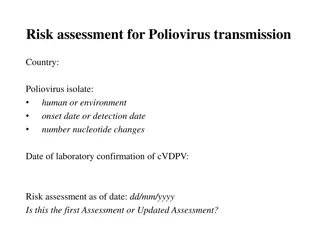
Epidemiology: Surveys, Sampling, and Monitoring
Explore the world of quantitative epidemiology, surveys, and sampling methods used in monitoring disease prevalence. Learn about census vs. survey, types of sampling, and more to enhance your knowledge in public health research.
Download Presentation

Please find below an Image/Link to download the presentation.
The content on the website is provided AS IS for your information and personal use only. It may not be sold, licensed, or shared on other websites without obtaining consent from the author. If you encounter any issues during the download, it is possible that the publisher has removed the file from their server.
You are allowed to download the files provided on this website for personal or commercial use, subject to the condition that they are used lawfully. All files are the property of their respective owners.
The content on the website is provided AS IS for your information and personal use only. It may not be sold, licensed, or shared on other websites without obtaining consent from the author.
E N D
Presentation Transcript
Quantitative epidemiology Survey Monitoring Surveillance
Survey Collection of data or information of a disease in a population. They are used to know the number of individuals, or number of diseased animal, characteristic of individuals such as weight, sex, milk yield etc. In epidemiology it is used for the estimation of the prevalence of disease, infection, or seropositive cases in animal population.
Census Vs. Survey If all the individuals of a population are investigated then it is called as census. In survey the sample plays an important role. If a survey is desingned in a way representing the population (sample) then the estimate can be made accurately by examining few individuals in a population
Sample Sample: It can be defined as a small proportion of individuals or items from a populations which represents the whole population or lot.
Sampling The target population: The total population about which information is required. The study population: It is the population from which a sample is drawn. Sampling frame: Identified individuals of a study population is the sampling frame. Each member of the sampling frame is called a sampling unit
Types of sampling Non-probability sampling: Depends on the choice of the investigator. Probability sampling: Sampling is made by unbiased process, so that each sampling unit in a group has an equal probability of being selected; this is the basis of random sampling.
Simple random sampling: the sample is selected randomly from the list of sample unit in a study population. Systematic sampling: It involves selection of sampling units at equal intervals, the first animal being selected Randomly. Systematic sampling is common in industrial quality control, such as selecting samples of goods on a conveyor belt.
Stratified sampling: A stratified random sample is obtained by dividing the study population into exclusive groups (strata), then randomly sampling units from all of the strata.
Cross-sectional survey : events occurring at a particular point in time. Longitudinal survey: events over a period of time. This can be recorded prospectively from the present into the future; or may be a retrospective record of past events. Screening: A particular type of diagnostic survey using a rapid test is screening. The aim of screening is to separate apparently healthy individuals from those that probably do not. Screening tests are not intended to be diagnostic
Monitoring The routine collection of information or observation on disease, productivity and other characteristics possibly related to them in a population.
Surveillance It is the intensive form of monitoring Initially it was used for tracing and observation of people in contactwith infection ordiseases Now, It involves the collection, collation and interpretation of data collected during monitoring programmes, It also intends to detecting population's health. changes in a
Elements of surveillance Gathering, recording and analysis of data; Dissemination of information to interested parties, so that Action can be taken to control disease.
Goals of surveillance Rapid detection of disease outbreaks; Identification of disease problems (endemic and non-endemic); Assessment of the health status of population; Definition of priorities for disease control and prevention;
Identification of new and emerging diseases; Evaluation of disease control programmes; Provision of information to plan and conduct research; Confirmation of absence of a specific disease.
Types of surveillance Disease surveillance Sentinel surveillance Serological surveillance Passive surveillance Active surveillance






















